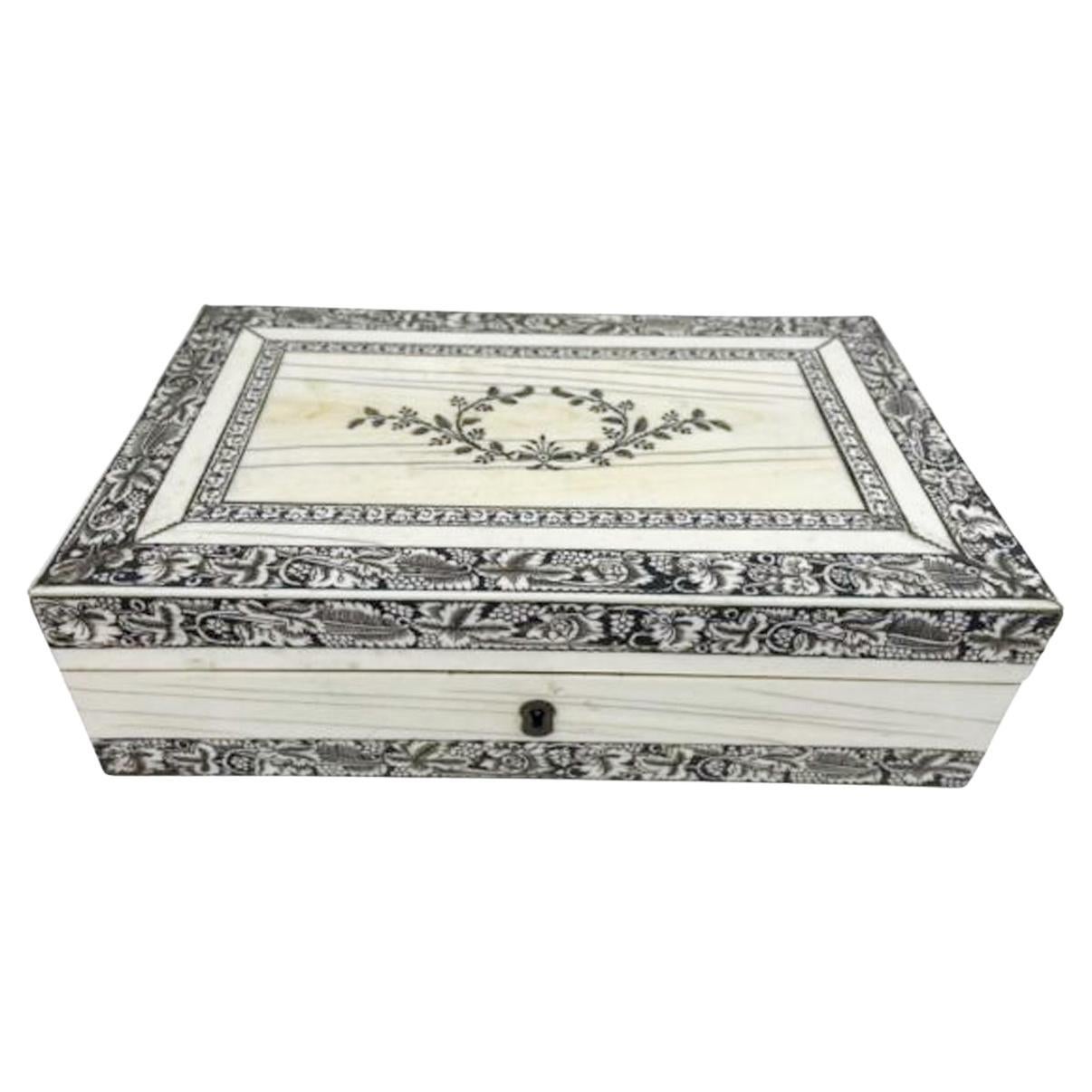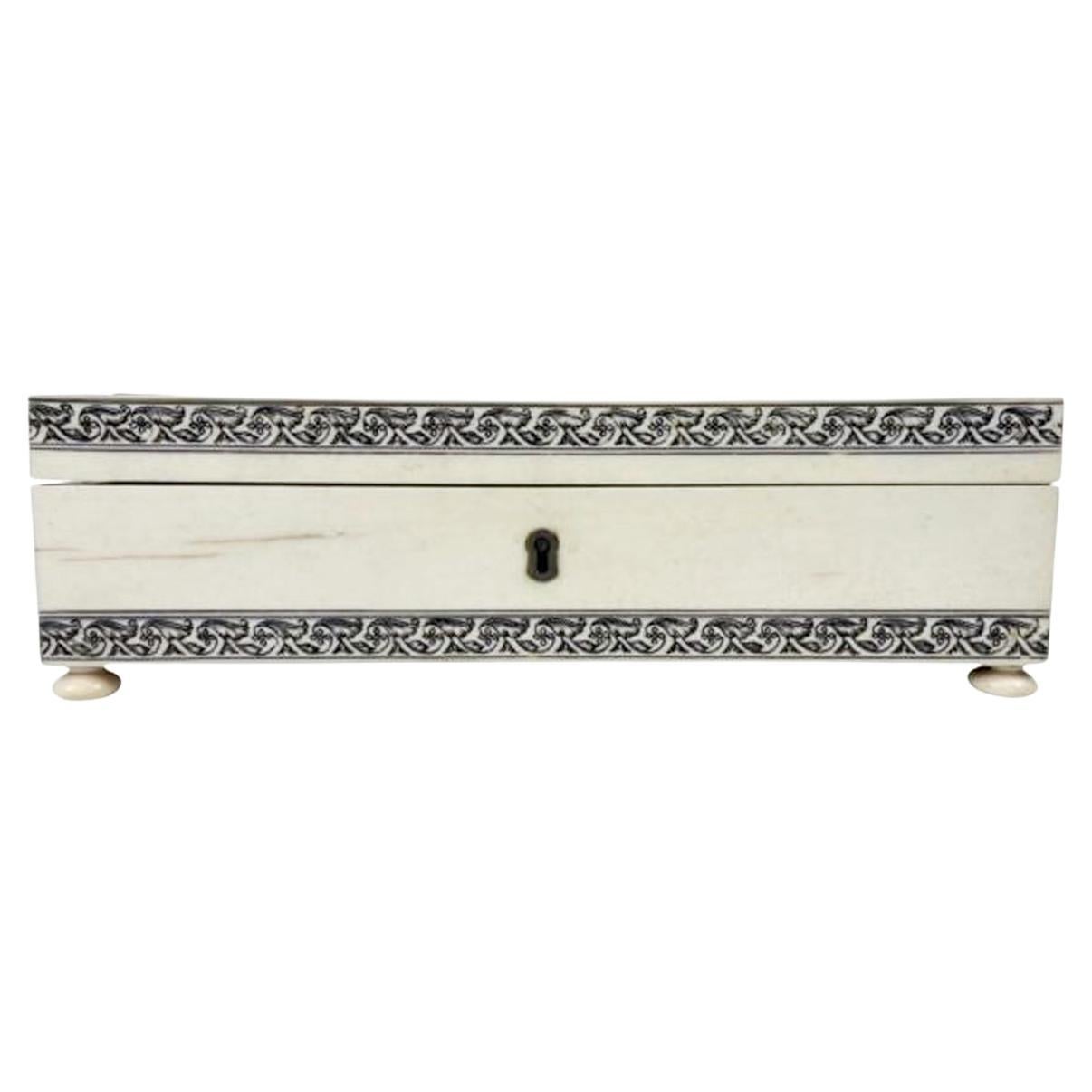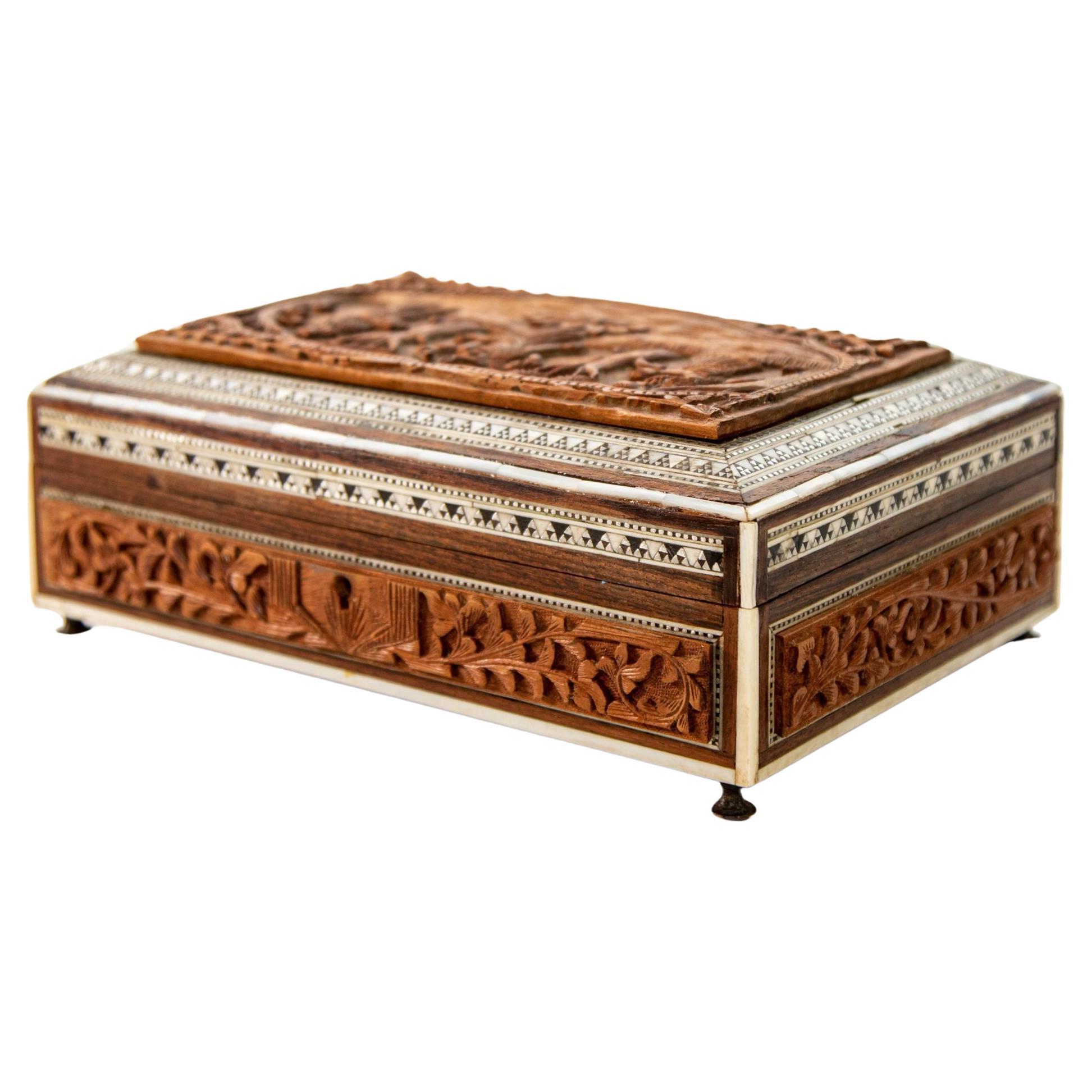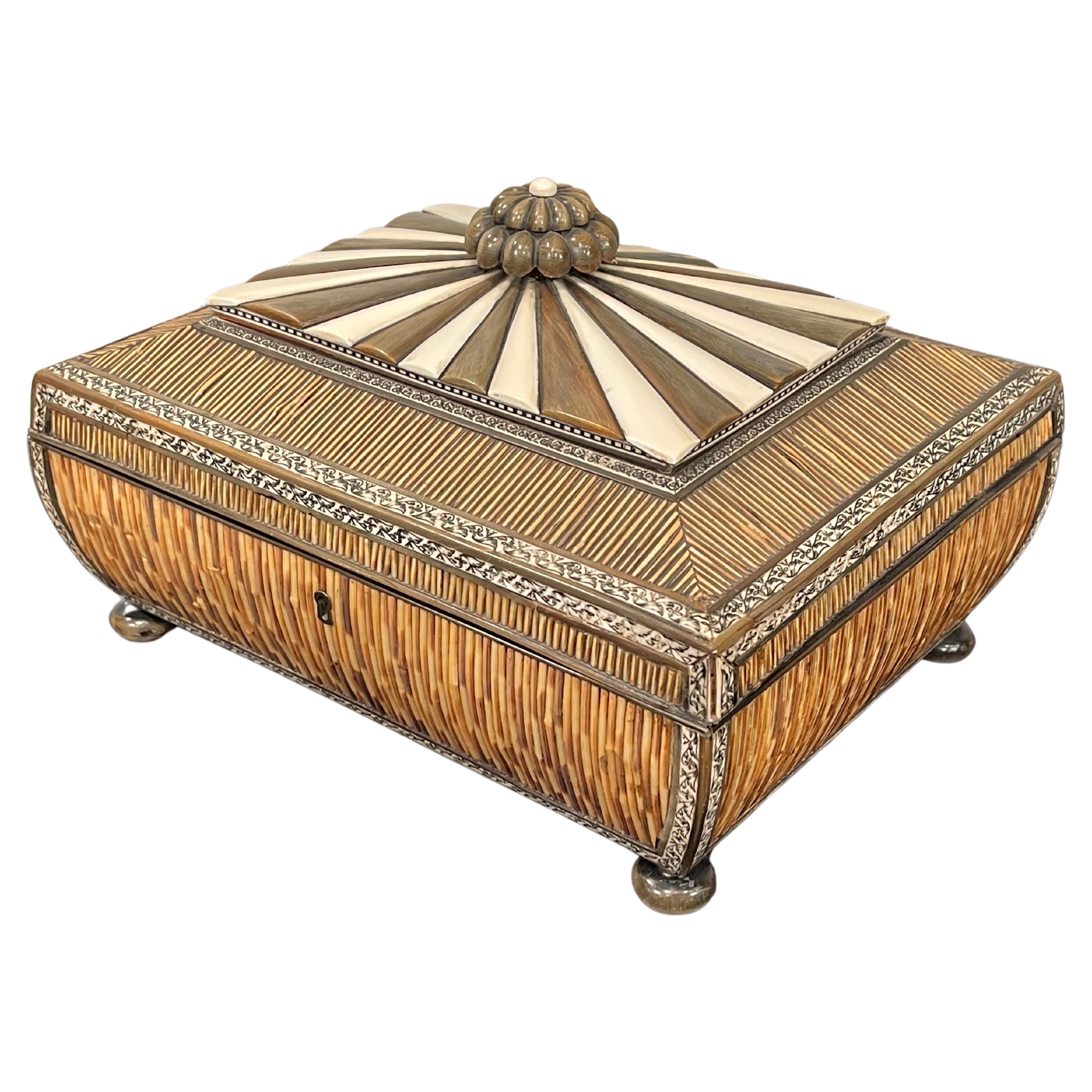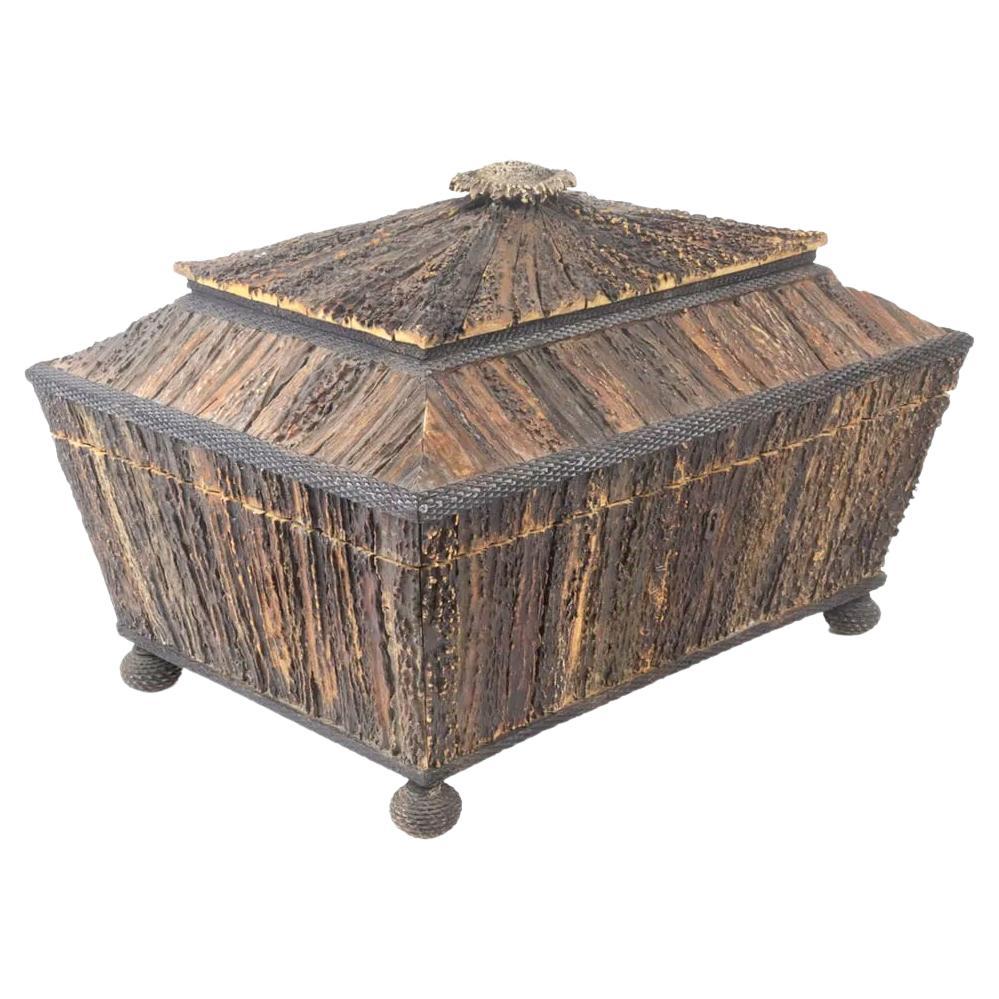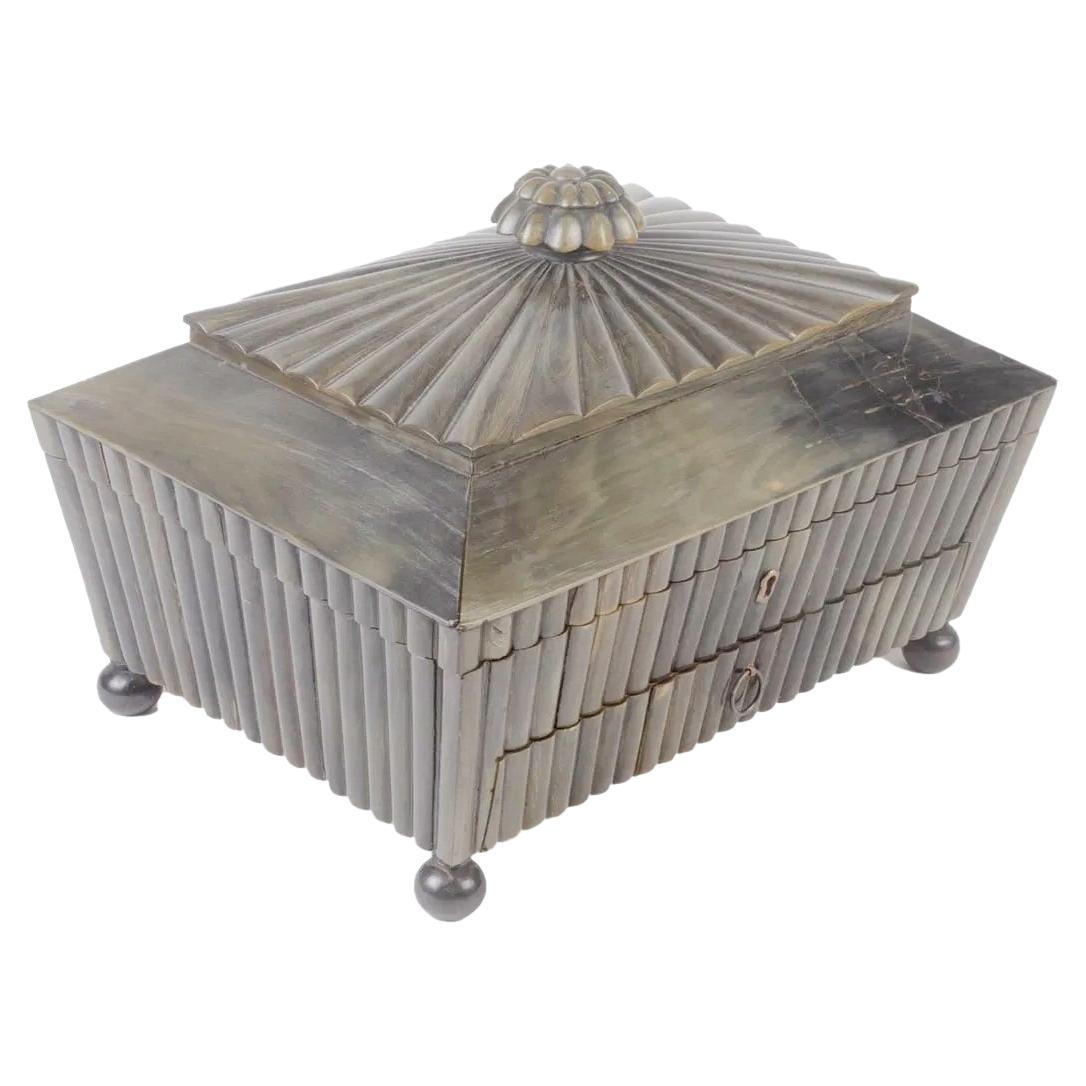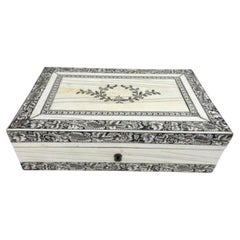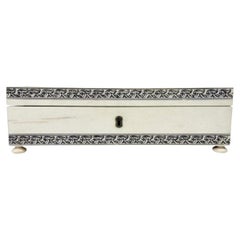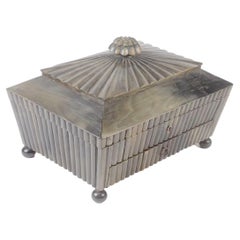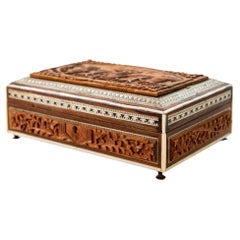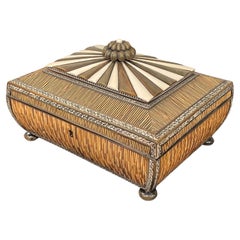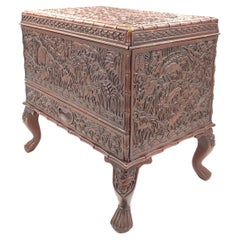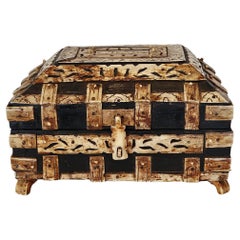Items Similar to Veneered Footed Sandalwood Sewing Box w/Penwork Decoration, Vizagapatam, India
Want more images or videos?
Request additional images or videos from the seller
1 of 13
Veneered Footed Sandalwood Sewing Box w/Penwork Decoration, Vizagapatam, India
$3,500
£2,619.70
€3,027.09
CA$4,853.33
A$5,436.36
CHF 2,826.30
MX$67,128.07
NOK 36,004.85
SEK 34,036.99
DKK 22,589.82
Shipping
Retrieving quote...The 1stDibs Promise:
Authenticity Guarantee,
Money-Back Guarantee,
24-Hour Cancellation
About the Item
Anglo-Indian penwork decorated veneered sandalwood box in the Regency taste, the two-tier sloped lid with a fluted carved upper tier above a smooth lower tier with penwork border and rectangular finial. the lower section raised on ball feet and containing a compartmented lift out tray above open storage area. Fitted with lock (no key) and silvered brass stop-hinges.
- Dimensions:Height: 4.25 in (10.8 cm)Width: 7.38 in (18.75 cm)Depth: 5.38 in (13.67 cm)
- Style:Anglo-Indian (Of the Period)
- Materials and Techniques:
- Place of Origin:
- Period:
- Date of Manufacture:1850
- Condition:Wear consistent with age and use.
- Seller Location:Chapel Hill, NC
- Reference Number:Seller: ACK1stDibs: LU7371242920242
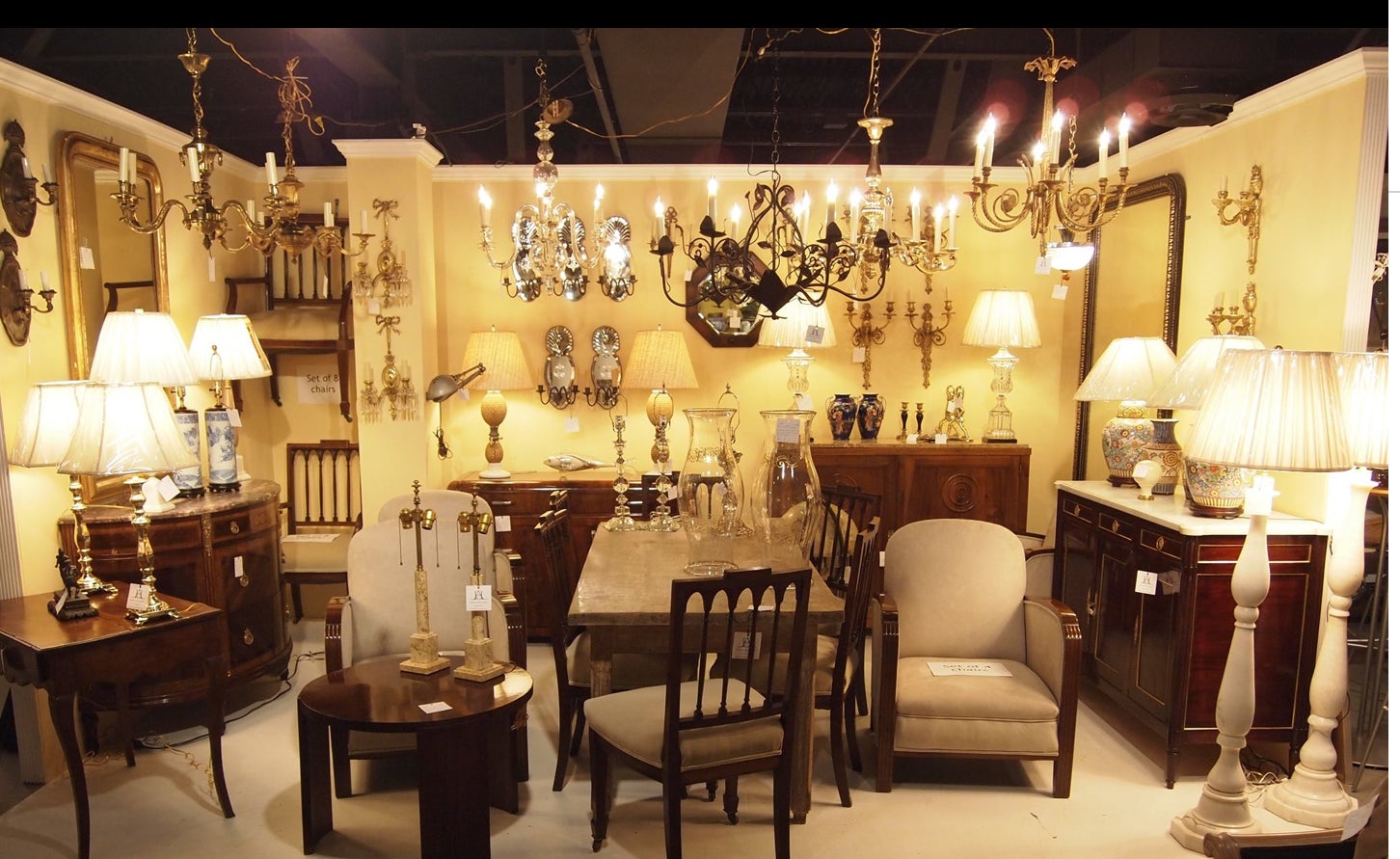
About the Seller
5.0
Platinum Seller
Premium sellers with a 4.7+ rating and 24-hour response times
Established in 1990
1stDibs seller since 2022
99 sales on 1stDibs
Typical response time: <1 hour
- ShippingRetrieving quote...Shipping from: Nantucket, MA
- Return Policy
Authenticity Guarantee
In the unlikely event there’s an issue with an item’s authenticity, contact us within 1 year for a full refund. DetailsMoney-Back Guarantee
If your item is not as described, is damaged in transit, or does not arrive, contact us within 7 days for a full refund. Details24-Hour Cancellation
You have a 24-hour grace period in which to reconsider your purchase, with no questions asked.Vetted Professional Sellers
Our world-class sellers must adhere to strict standards for service and quality, maintaining the integrity of our listings.Price-Match Guarantee
If you find that a seller listed the same item for a lower price elsewhere, we’ll match it.Trusted Global Delivery
Our best-in-class carrier network provides specialized shipping options worldwide, including custom delivery.More From This Seller
View AllVeneered Sandalwood Dresser Box with Penwork Decoration, Vizagapatam, India
Located in Chapel Hill, NC
Rectangular penwork decorated veneer on sandalwood box. The top with a double border centering a floral cartouche, the four sides with wide leafy borders to top and bottom. Fitted wi...
Category
Antique Mid-19th Century Indian Anglo-Indian Decorative Boxes
Materials
Metal
Veneered Footed Sandalwood Glove Box with Penwork Decoration, Vizagapatam, India
Located in Chapel Hill, NC
Anglo-Indian penwork decorated veneered sandalwood glove box on turned ball feet the sides and top decorated with scrolling leaf borders and the top with a central leaf-framed cartou...
Category
Antique Mid-19th Century Indian Anglo-Indian Decorative Boxes
Materials
Metal
Exceptional Anglo-Indian Stag Horn Veneered Sewing / Work Box From Vizagapatam
Located in Chapel Hill, NC
An unusually large stag horn veneered sandal wood sewing box from Vizagapatam, India. This large, fitted box in the Regency taste has tapered sides and a two-tiered sloped lid, all c...
Category
Antique Mid-19th Century Indian Anglo-Indian Decorative Boxes
Materials
Antler, Sandalwood
Anglo-Indian Horn Veneered Sewing Box from Vizagapatam w/Fitted Interior/Drawer
Located in Chapel Hill, NC
Large Anglo-Indian sewing box with hinged lid opening to a fitted interior and interior compartment in the lid, a lower drawer on the front provides additional storage. The box made ...
Category
Antique Mid-19th Century Indian Anglo-Indian Decorative Boxes
Materials
Horn, Sandalwood
Regency Brass Inlaid and Bound Thuya Wood Jewlery or Dresser Box
Located in Chapel Hill, NC
Late Georgian / Early Victorian dresser box in thuya wood burl with quarter round brass edges, the top and front inlaid with brass lines connecting decorative corner devices centerin...
Category
Antique Mid-19th Century English Early Victorian Jewelry Boxes
Materials
Brass
Anglo-Indian Ribbed Horn Box with Sandalwood Interior
Located in Chapel Hill, NC
Anglo-Indian glove or trinket box from Vizagapatam of rectangular form with sloped top. Made from sandalwood with vertically ribbed horn veneered sides and starburst ribbed lid with ...
Category
Antique Mid-19th Century Indian Anglo Raj Decorative Boxes
Materials
Horn, Wood
You May Also Like
Antique Anglo-Indian Vizagapatam Jewelry Inlaid Sadeli Footed Box
Located in North Hollywood, CA
Antique 19th century Anglo-Indian jewelry, trinket footed box, inlay with ebony, mosaic marquetry Sadeli work and a carved Hindu scene on top.
The box case is made from sandalwood wi...
Category
Early 20th Century Indian Anglo-Indian Decorative Boxes
Materials
Bone, Mother-of-Pearl, Wood
Regency Anglo Indian Quill Work Vizagapatam Sandalwood Sewing Box
Located in Huntington, NY
This fine Regency period quill work, bone, ivory & sandalwood sewing box
with intact interior w sewing implements.
Category
Antique Early 19th Century Indian Regency Decorative Boxes
Materials
Bone, Ivory, Sandalwood
$13,200 Sale Price
20% Off
Large 19th Century Sandalwood Jewellery Box, South India
Located in London, GB
The dense carving of this 19th century South Indian sandalwood jewellery box is so lively and animated.
Category
Antique Late 19th Century Indian Jewelry Boxes
Materials
Sandalwood
Antique Vizagapatam India Table Box Ebonized Wood & Bone Carvings
Located in Forney, TX
Vizagapatam box, India, 19th century.
This highly decorative and unusual Anglo-Indian table box features rustic workmanship that adds to the character and charm of this unique Sout...
Category
Antique 19th Century Indian Anglo Raj Decorative Boxes
Materials
Bone, Wood
19C Anglo Indian Highly Carved Teak Sadeli Mosaic Inlaid Sewing Box
Located in Dallas, TX
PRESENTING A LOVELY 19C Anglo Indian Highly Carved Sadeli Mosaic Inlaid Sewing Box.
Made in Bombay, India, circa 1880.
The box is made of sandalwood with highly carved raised teak wood panels on all sides, depicting temple scenes, animals and foliage.
The box is in a sarcophagus form.
It is edged in bone (and we can tell it is bone and not ivory, from the color and evidence of capillaries, which are not found in ivory), and banded with Bombay Sadeli mosaic and ebony veneer.
The lid opens to reveal a removable tray with various open compartments and lidded compartments. 5 lidded compartments, 1 unlidded compartment and 8 holders for thimbles, etc
The tray lifts to reveal a blue velvet (original) lined section, for storing jewelry etc, with sections for collars etc.
The inside of the lid has a removable mirror (the mirror is missing on this one but can easily be replaced). Behind the mirror is the original green velvet lining.
It has its original brass carry handles on the sides and sits on 4 silvered button feet (of recent origin).
Some repairs to the exterior and condition issues (priced accordingly), but still a LOVELY COLLECTIBLE box!
These boxes were made by superb Indian craftsmen, specifically for sale to the ruling British elite. These types of boxes, carved padouk and sandalwood, (whilst beautiful and superbly crafted) were of a lesser quality, than the more profusely and intricately mosaic inlay, tortoiseshell and ivory boxes, made for the British ‘Upper Classes’ in the areas of Bombay and Vizagapatam. These type of boxes were much more affordable back in 1880 (and indeed today) and would probably have been bought by mid-level diplomats, civil servants or visitors.
Sewing boxes (in general), were in EVERY Victorian home in Britain in the 19th century and like other boxes etc were ‘status symbols’ of your place in society! The more ornate the box, the more ‘Upper Class’ you were!
SADELI MOSAIC: “Anglo Indian boxes were made in India for the English residents from the early part of the 18th century. They were brought back or sent back to England usually by the people who had commissioned them. From the beginning of the nineteenth century they were imported more commercially, although not in any significant numbers until the middle decades. They were very highly valued, especially the early ones, to the extent that the designs were copied on late 19th and early 20th century tins.
The ancient art of Sadeli Mosaic is said to have been introduced from Shiraz in Persia via Sind to Bombay, a long time before the Anglo Indian boxes were made. It was a technique, which required a high degree of skill and patience. It was executed very lavishly, in that the frequent cuts wasted a great amount of the precious materials used. The workmanship was however more than commensurable to the value of the materials.
Ivory, silver, pewter (or other metals), wood and Horn were cut into faceted rods which were bound together to form geometric patterns. When the glue has set, the rods were sliced in transverse sections. This gave the maker a number of angled circular pieces in the original pattern. Several variations of patterns could be achieved by combining the materials in different ways. The ivory was sometimes dyed green to give an extra color.
The mosaic pieces in a combination of patterns, often separated by ivory, ebony, Horn or silver stringing were used to veneer sandalwood boxes. In the early boxes, which date from the turn of the 18th to the 19th century, there are large panels of mosaic covering tops and sides of boxes. It took incredible skill to cover such large areas without any shakes or wavering of the pattern. The corners and joins on these boxes are impeccably matched.
The makers (reputed to be Persian) of Sadeli mosaic made in the first two decades of the 19th century displayed a total understanding of the qualities of the different materials they used. They combined substances, which can expand and contract according to atmospheric conditions with others, which are hard and unyielding. The result was a sharp definition of the lines and patterns, which made up the whole design.
On the early boxes the designs look deceptively simple. The fact is, they emerged from a culture, which had mastered geometry and understood how to generate a pattern from a set number of points. The patterns are so harmoniously combined that their incredible complexity is not immediately apparent.
The earliest Sadeli boxes...
Category
Antique Late 19th Century Indian Anglo-Indian Decorative Boxes
Materials
Bone, Sandalwood, Teak
Anglo-Indian Vizagapatam Bombay Mughal Style Footed Box With Bone Overlay
Located in North Hollywood, CA
Nice and unusual Indian Mughal style large decorative box, filigree and carved horn.
Anglo-Indian footed domed box with exceptional engraved details throughout with filigree and carved veneered bone plaques with arabesque carving.
Vizagapatam, late 19th century.
History of the Anglo-Indian Boxes
Beginning in the early part of the 18th century, Indian artisans made what came to be known as Anglo-Indian boxes for the English residents living in India, who eventually brought or sent them back to England. At the beginning of the 19th century, India began exporting these boxes commercially, although not in any significant numbers until the 1850s. People valued them so highly that manufacturers of tins copied the designs on them in the late 19th and early 20th century.
Anglo-Indian boxes fall into four groups: Rosewood or ebony boxes inlaid;
sandalwood boxes veneered; sandalwood boxes covered with Sadeli mosaic; and carved boxes often combined with Sadeli mosaic/
The first two categories came from Vizagapatam in East India while the last two came from Bombay in West India.
English traders discovered the rich woods and intricate workmanship of Indian artisans, so colonial government officials began to recognize the work of the Indian artists and craftsmen as a source for satisfying the need for furniture and boxes, which would both serve to enhance English households in India. This gave rise to the cabinetmaking workshops in Vizagapatam between Calcutta and Madras.
Craftsmen made the first boxes to be decorated with Sadeli mosaic of rosewood or ebony, incised to give further definition to the decoration, directly inlaid into the wood. The shape of the early boxes was either sloping at the front with a flatter section at the back, reminiscent of English writing slopes, or rectangular. Artisans inlaid the borders with stylized floral scrolls and the centers with a single floral motif following a circular or oval symmetrical or asymmetrical pattern. The edging was ornamental and protective, both helped protect the end grain against the weather.
Made in Vizagapatam, situated on the south east coast of India, near Madras
These exotic boxes...
Category
Antique Late 19th Century Indian Anglo Raj Decorative Boxes
Materials
Wood
More Ways To Browse
Silver Box India
Silver Boxes Trays
Silver Storage Box
Mid Century Sewing
Sewing Storage
Brass Tray India
Antique Sewing Storage
Silver Tray 1850
Tier Tray Silver
Anglo Indian Tray
Indian Silver Tray
Bone Flute
Anglo Indian Tray Brass
Anglo Indian Carved Tray
Antique Crystal Plates
Arts And Crafts Chandeliers
Bauhaus Metal Lamps
Beautiful Antique Picture Frames
